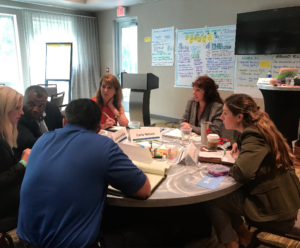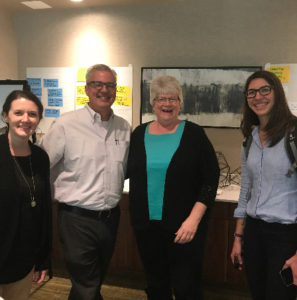Connections Create a More Sustainable Tennessee Valley

Running a city or county’s sustainability efforts can be a lonely job. Small departments face an enormous challenge and often scarce resources. Often, it can be hard for government staff to build relationships with the power utilities serving their community in order to improve energy efficiency, reduce greenhouse gas emissions, or work toward alternative power sources. When sustainability officers can connect with and learn from one another, it’s often a win-win. And when sustainability networks can bring local utility companies and a large, regional electric power producer into the mix, it advances the work of sustainability all the more. That’s what happened with five SSDN member cities, their local power companies (LPCs), and the Tennessee Valley Authority (TVA). By building relationships between city sustainability efforts and utilities, they’re building a more sustainable region.

“We’ve been working tangentially with TVA and our local utility for ten years, but now the utility business model is changing,” says Robin Cox, SSDN co-chair and a former City of Huntsville sustainability employee who now serves as a consultant facilitating the relationship between cities and their utilities. “We’re all becoming more aligned at the regional and local levels, as more cities come on board to do greenhouse gas reduction and invest in distributed renewable energy sources.”
About the Tennessee Valley Authority (TVA)
The Tennessee Valley Authority (TVA) is a public power generation and transmission entity that sells power to 154 local power companies (LPCs) that distribute it throughout Tennessee and parts of Alabama, Georgia, Kentucky, Mississippi, North Carolina and Virginia, serving 10 million people. It also sells power directly to larger industries in the region. TVA was created in the 1930s in response to the Great Depression, to address energy, economic development and environmental stewardship in the Tennessee Valley. Although it was created by the federal government, it is a completely self-funded public corporation.
Peer-to-Peer Exchange in the Tennessee Valley
The partnership between TVA, LPCs, and sustainability offices grew from the roots of the SSDN network and a mutual interest in low-income energy efficiency.
“I would talk regularly with my Huntsville colleague, Robin Cox, about some of the low-income energy efficiency work we were doing, and we had gotten to know each other and other city sustainability folks through SSDN,” says Erin Gill, Sustainability Director in Knoxville, Tennessee.
In 2014, Knoxville and Huntsville both received Extreme Energy Makeover grants from TVA and began exploring ways to work with local utilities to improve energy efficiency in low-income homes. With the help of a USDN Innovation Fund grant, Memphis, Knoxville, and Huntsville joined with other SSDN members to develop an Energy Efficiency and Equity Toolkit in 2016.
“We were able to initiate and lead conversations about equity with our utility partners. We learn from them, and they learn from us. In many ways, utilities can now see us as collaborators, not just customers or stakeholders.”
— Erin Gill, City of Knoxville, Director of Sustainability
“We realized that there was a lot of interest within SSDN around equity and the low-income built environment,” says Gill.
Meanwhile, TVA was exploring low-income energy efficiency as well. The Extreme Energy Makeover program was part of that work, along with listening sessions to learn how to get energy efficiency knowledge and tools into the hands of low-income residents more effectively. In 2015, TVA introduced its Home Uplift program to support local weatherization and energy efficiency upgrade efforts.
“In our long arc of conversation with multiple cities, we kept hearing about exciting and innovative things other cities were interested in or already working on in partnership with their local utility,” says Gill. “And we were simultaneously talking to TVA about being allies in low-income energy efficiency, so bringing it all together into one larger conversation just seemed to make sense.”
In 2017, USDN provided a grant to support a gathering of the “big five” cities in the Tennessee Valley Authority’s service area (Memphis, Nashville, Knoxville, Chattanooga and Huntsville) along with their LPC representatives and TVA. SSDN coordinated the first peer exchange, which took place in Nashville in July 2017. SSDN members worked with leaders from LPCs and TVA to create the agenda.
“We really wanted this to be a partnership,” says Gill. “In fact, the sustainability offices and LPCs presented together about their local work to kick off our discussions.”
The 2017 gathering was so successful that the group met again in August 2018, this time with funding in large part from TVA.
During peer exchanges, participant cities and utility representatives share and discuss ideas that are working in other cities and how they might apply them throughout the Tennessee Valley. For example, Knoxville’s “Round it Up” program helps generate funds for low-income weatherization work. Nashville launched its first community solar project. Both these and other practices are generating conversations that may grow them into regional, rather than local, approaches.
The peer exchanges have fundamentally changed the relationship between cities, their LPCs, and the Tennessee Valley Authority. Whereas some cities had no relationship with TVA beforehand and may have struggled to form connections with their LPCs, now all recognize where goals and values align and what each can bring to the table and learn from one another. The cities see LPCs and TVA as sustainability allies rather than adversaries, and the utilities recognize the expertise and connections that cities bring to the mix.
“The peer exchanges have helped us, as sustainability offices, build our own capacity,” says Gill. “Because of our work with the USDN equity grant, we were able to initiate and lead conversations about equity with our utility partners. We learn from them, and they learn from us. In many ways, utilities can now see us as collaborators, not just customers or stakeholders.”
“I believe our relationship with the Tennessee Valley Authority has become more of a partnership, whereas before it was more transactional,” says Eric Schmidt, Director of Sustainability in Chattanooga. “We now have a little more say in what we want and what might improve service and opportunity in Chattanooga.”
“We have a much better understanding of how TVA functions and makes decisions… now we understand their specific goals and know that they are open to hearing from us and taking our suggestions.”
— Laurel Creech, Assistance Director of Metro Nashville’s Department of General Services’ Division of Sustainability
“We have a much better understanding of how TVA functions and makes decisions,” says Laurel Creech, Assistant Director of Metro Nashville’s Department of General Services’ Division of Sustainability. “Before, there was this perception of TVA as ‘the bad guy’ – but now we understand their specific goals and know that they are open to hearing from us and taking our suggestions. There are staff at TVA who really care about the things we care about.”
Building Local Relationships

The other big win from the peer learning exchanges is better, deeper relationships between cities and their LPCs. Participants report that the meetings gave them a reason to reach out and work together – not just on initial presentations but on implementation of approaches to low-income weatherization work and other programs.
“The peer exchange meetings help us know we’re where we should be,” says Joe Gehrdes, Community Relations Manager at Huntsville Utilities. “We’d like to be cutting edge, and we certainly don’t want to be left behind. When we talk with other utilities that are doing similar work, we can come together to determine best practice.”
The peer exchanges gave Huntsville Utilities the confidence to move forward with a bill assistance program, called Project Share, and reserve some of those proceeds to fund low-income energy retrofits —knowing that partners in the City’s Operation Green Team will find opportunities to help fund and implement that work.
“This is all unique because we’re all doing the same things at the same time, and been able to move one another’s work forward,” says Cox. The growing relationships also are connecting the dots between what TVA offers and what LPCs are willing to do. For example, TVA had applications available for community solar projects. The Nashville’s Mayor’s office encouraged their LPC to pursue the opportunity and provide support. Since then, the city and LPC have partnered with TVA to create a two-megawatt community solar project in Nashville.
Increasing Low-Income Energy Efficiency
Since awarding the Extreme Energy Makeover grants in Knoxville and Huntsville, TVA’s Home Uplift program has brought money to the table to do low-income weatherization, letting the local community define how to deploy it.
“Energy efficiency provides benefits to utilities and customers, particularly for low-income families,” says Michael Scalf, Senior Strategic Consultant for TVA. “We know that sustainability directors and mayors have goals to be successful in doing the right thing for residents. We rely on the expertise of cities and their partners, and understand that they are testing models that can be expanded or replicated among all cities.”
In the process, the “big five” cities in the TVA region have leveraged the investments made by governments, LPCs and TVA. Four of the five cities have received grants from SSDN’s Southeast Sustainable Communities Fund (SSCF) to help implement or scale up low-income energy efficiency programs. Several cities received $500,000 from the Federal Home Loan Bank to support energy efficiency for those in extreme poverty or with disabilities.
SSDN cities are also using the peer exchange and networking opportunities with TVA to expand the breadth of their low-income energy efficiency work. For example, several are now incorporating job training and workforce development as a part of weatherization.
“We modeled our workforce development approach after a program in Knoxville, which they started with a TVA grant,” says Schmidt. “We saw how well it was working and modified it for our city, and now TVA is a supporter of our workforce development programs as well.”
“We continue to refine how we approach education for energy efficiency, especially among low-income customers.” Says Gill. “And we continue to learn from other cities and improve our efforts based on what they have done. For example, our workforce development program incorporates training materials from Nashville. We all borrow ideas from one another about specific approaches or funding strategies, improve them, and then share them with others. Ultimately as a region we’ll have a whole suite of measures around weatherization, education, outreach, etc. that will spread to smaller communities and utilities that are not part of the SSDN network.”
What’s Next in the Tennessee Valley
TVA, LPCs, and cities are also exploring the impact of energy efficiency and weatherization on air quality and health. For example, poor heating or cooling can result in mold or other contaminants that can cause respiratory symptoms that can result in medical costs, missed days of work, or other related challenges to residents.
TVA’s Home Uplift program seeks to quantify the non-energy benefits of energy efficiency work. TVA is working with a Knoxville-based nonprofit, Three3 (Three Cubed), that has experience in doing weatherization program evaluations nationally, to help determine the impact of weatherization on health in TVA’s “big five” cities. LPCs are key partners in this work, gathering data to inform the evaluation.
“As we transition to cleaner energy sources we see alignment at both the local and regional levels… Technology and these strategic partnerships enable us to drive toward a cleaner, more energy efficient future in the Valley.”
— Michael Scalf, Senior Strategic Consultant to the Tennessee Valley Authority
“TVA has shown us that they have an appetite for this work,” says Gehrdes. “They have some of the neediest customers in the country in their footprint. Pilots like their Uplift program help us learn how to deliver efficiency on the energy side and then add home health. In return, we are gathering home health data as we do the energy efficiency work to help determine how it has an impact.”
“It’s been nice to come together with a larger group and find that same will and appetite to help customers get out of the vicious cycle of high utility bills that exacerbate any respiratory or related health problems they may have,” he adds. “That’s the kind of change that helps you sleep at night. We’re looking forward to doing more, and we won’t stop looking for opportunities – so we’re looking at what others are doing and determining how to add that to a Huntsville Utilities program.”
Energy Alternatives
In addition to weatherization efforts, cities, TVA and LPCs are also looking at an overall slowing demand for electricity and increases in demand for greener options, such as solar energy. This, coupled with the growth of Distributed Energy Resources (DERs) – smaller power generating installations like rooftop solar that interact with larger traditional power grids – means power generators and distributors will need to work more closely with communities to develop viable and equitable options.
“As we transition to cleaner energy sources we see alignment at both the local and regional levels,” says TVA’s Scalf. “Technology and these strategic partnerships enable us to drive toward a cleaner, more energy efficient future in the Valley.”
In Nashville, the city and LPC, Nashville Electric Service (NES), are responding to an increase in electric vehicle use among consumers. The city has many charging stations, but they have not been sub-metered, so there was no way to tell how much energy they were using. NES is reviewing the option to have a different rate and/or meter for the charging stations so the city can see how much it’s spending on EV charging.
The “big five” also collaborated to share comments that will help inform TVA’s 2019 Integrated Resource Plan — a regional first. With support from SSDN, the city sustainability directors coordinated to identify key themes and advocate for more sustainable energy resources.
“The TVA region is doing a lot, and in very innovative ways,” says Gill. “I have really benefited and been fulfilled by the fact that all of our cities, LPCs, and TVA are pulling together, because that’s how we’re going to change the entire energy system.”
The Southeast Sustainability Directors Network (SSDN) is a network of more than 60 local government sustainability officials in the Southeastern United States dedicated to advancing sustainable and equitable best practices throughout the region.
For more information please visit www.southeastsdn.org.
Contact: Meg Jamison, meg@southeastsdn.org
All images are used with permission from the City of Chattanooga, Memphis-Shelby County, City of Huntsville, City of Nashville and City of Knoxville.